This is a real Panang Curry recipe for curry connoisseurs who adore authentic Thai food! It’s made using a homemade Panang Curry paste which is easy to make but will likely call for a trip to the Asian store. But if you truly want the best, it’s worth it. You can’t get good Panang curry in jars!
Make this creamy coconut Panang curry with either prawns/shrimp or chicken. Both are great!
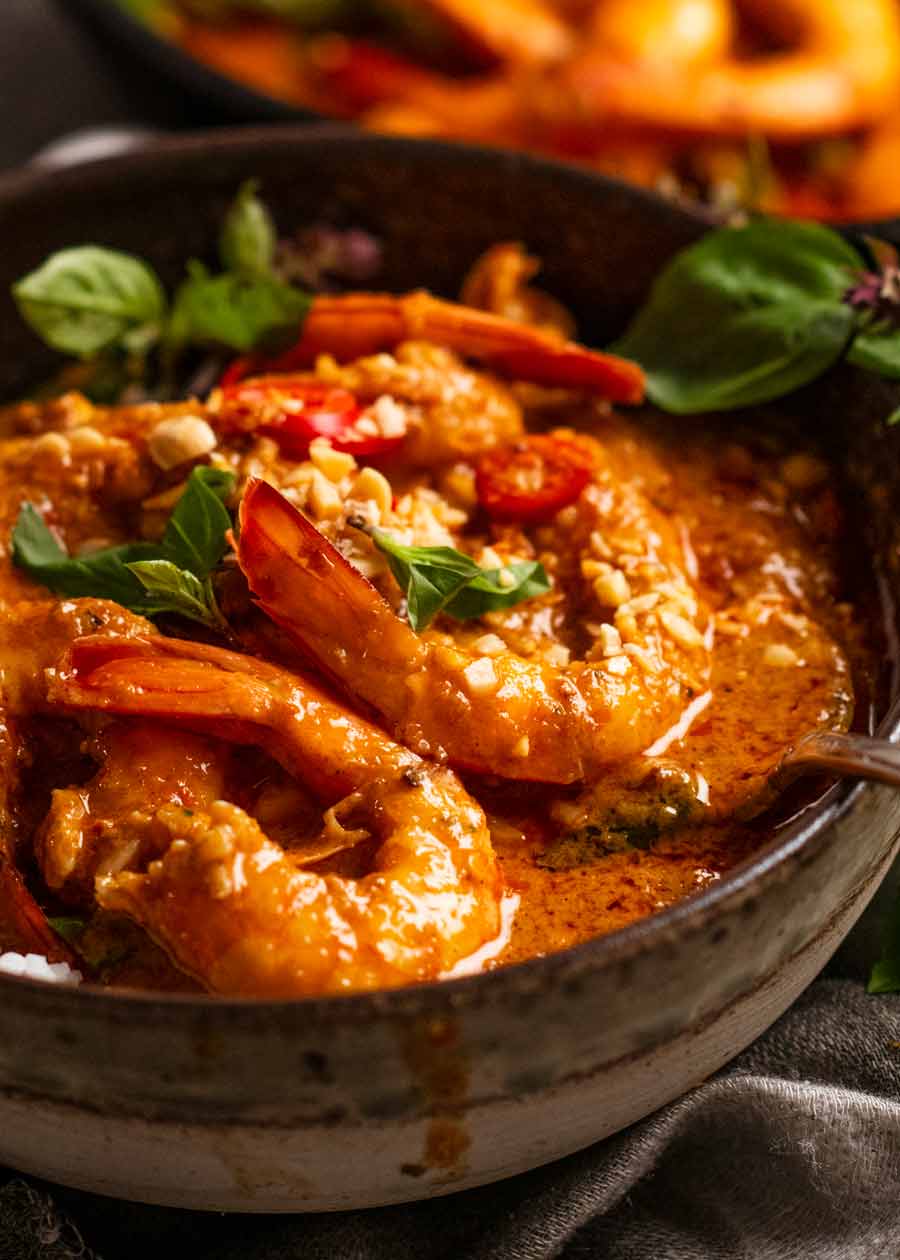
I only make Panang curry from scratch
This is a recipe for Thai Panang curry that is entirely made from scratch, including a homemade Panang curry paste. While I’ll happily make Thai Red and Green curry using my favourite curry paste from a jar, nothing compares to a Panang Curry paste when you make it yourself from fresh ingredients!
Even the Panang curry paste by my favourite Maesri brand falls too short compared to homemade. Well, maybe that’s going too far. It makes a tasty enough curry. But not a real deal Panang curry!
What Panang curry tastes like
Panang Curry tastes like a more intense version of Thai Red Curry. While it has similar ingredients, Panang curry is a bit stronger, richer, sweeter and thicker than Red Curry, as well as slightly nutty thanks to the addition of ground peanuts in the paste.
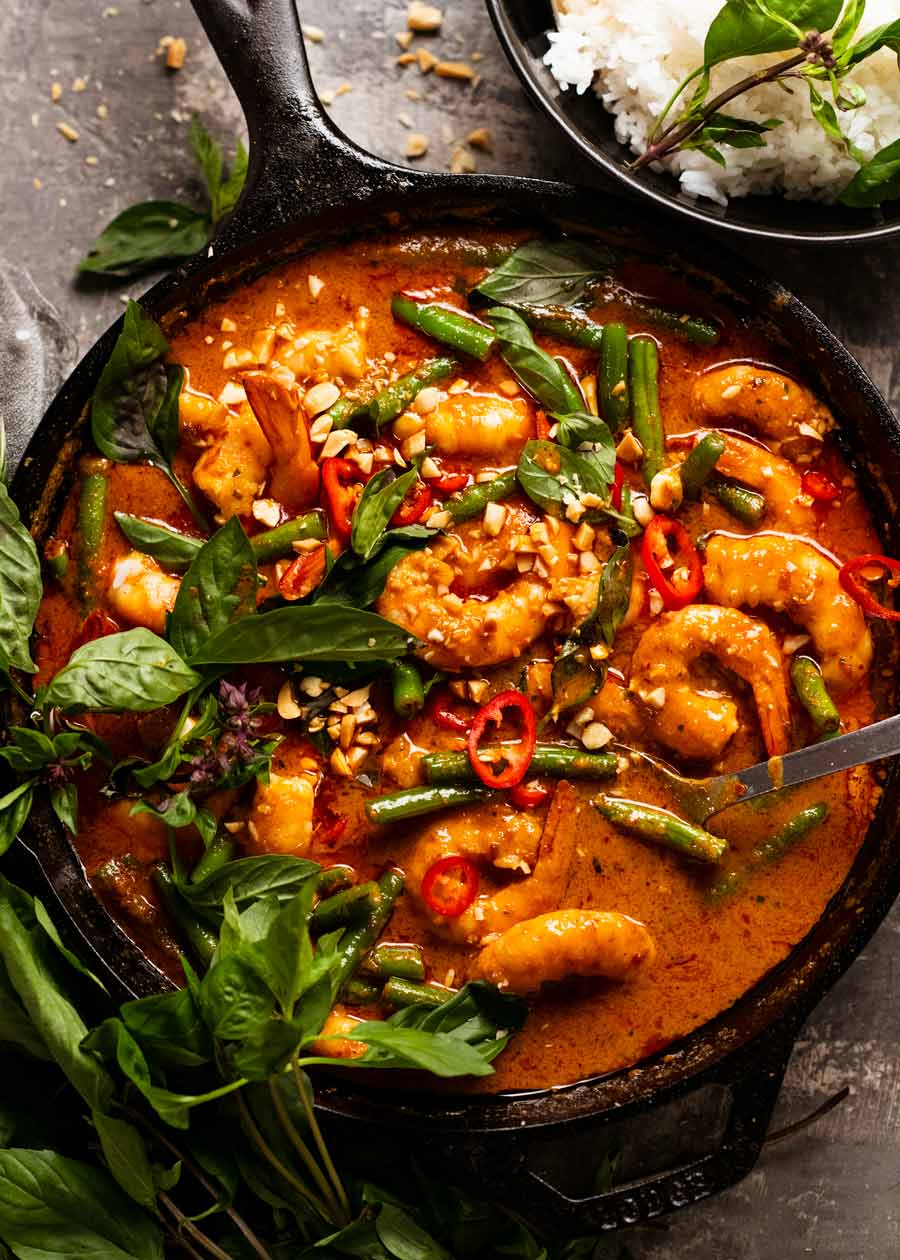


Panang curry is spicy. Deal with it!
Panang curry is spicy. But unlike most other curry recipes, you cannot reduce the spiciness without losing flavour because chillies are the key ingredient for Penang curry sauce.
How spicy, you ask? Thais would class this Panang curry as medium or “not so spicy”. For Westerners, it’s probably getting up towards hot. But not volcanic. General consensus amongst my team is that it’s a 7 out of 10 on the spicy scale. The only other curry on my website that hits this level of spiciness is Vindaloo, if that’s a useful comparable for you.
So if you can’t handle spicy food, I suggest you give Panang Curry a miss and make a milder Thai Yellow Curry or Massaman Curry instead!
* Spiciness testing: My team and I worked on this Panang curry recipe a LOT. We did so many variations to stress test the spiciness and we are all in agreement that if you reduce the chillis to reduce spiciness, you lose flavour and it’s not Panang curry. We ended up creating a recipe using milder Chinese chillies rather than spicy Thai ones, to get enough sauce flavour without blowing our heads off.

OK, due warning on the topic of spiciness given. On to the recipe!
Panang curry ingredients
First, I’ll run through the beautiful fresh ingredients for the homemade Panang curry paste. Then all the good stuff that goes in the curry!
Panang curry paste ingredients
There’s a fair few Asian specific ingredients here, but familiar ingredients to those who have made other homemade Thai curries. In particular, Thai Red Curry – because the ingredients are virtually the same!
It will require a trip to the Asian store, though you can actually get everything at Harris Farms and the larger grocery stores in Australia, with the exception of shrimp paste (but there’s a substitute for that).

Dried chilli – Key ingredient, so discussed below. Don’t get this wrong – you will regret it! 🔥
Lemongrass – Fresh is best but if you can’t get it, use 1 tablespoon of lemongrass paste instead.
Galangal – looks like ginger but is more citrusy and harder. It’s pretty tough so best to grate to ensure your curry paste is smooth, otherwise you risk lumps in your sauce. You can find it in Asian stores + some grocery stores in Australia (Harris Farms and some Woolworths sell it). Substitute: use the same amount of ginger + 1/4 tsp lime zest.
Shrimp paste in bean oil – I use Por Kwan Shrimp Paste in Bean Oil, pictured below, the most popular one sold at Asian grocery stores here in Australia. Substitute with 1 1/2 tsp belacan dried shrimp paste, roughly chopped (even sold at Woolies in Australia!) + 1 tsp oil + 1 tsp fish sauce + 1 garlic clove + 1 tsp miso, if you can – any type). Use in place of shrimp paste in recipe.
Kaffir lime leaves – Earthy lime flavour unlike anything else! Sold at Asian stores, Harris Farms & large grocery stores in Australia. Freezes 100% perfectly – used in Thai red curry, coconut rice, Thai meatballs.
Eschalot (US: Shallot) – Also known as French onions and called “shallots” in the US. They are like baby onions, but with purple-skinned flesh. Not to be confused with what some people in Australia call “shallots”, ie. the long green onions. Substitute with half a red onion.
Garlic – 5 whole cloves!
Peanuts – This is what gives the Panang curry the signature peanut-y flavour. Beats using a scoop of peanut butter any day!
Dried spices – Cumin, coriander and nutmeg.

Dried chilli for Panang curry paste
Dried chilli is the key ingredient in Panang curry, for both sauce flavour and colour. It is also what makes Panang curry spicy. But if you reduce the chilli, you will lose sauce flavour. So as recommended above, if you can’t handle spicy food, it is best to give this a miss.

Chilli type matters!! Use Chinese dried chillies, not Thai or Indian! I know it sounds strange to tell you not to use Thai dried chillies but they are SUPER spicy and unlike Chinese chillis, they don’t reduce in spiciness much when cooked. Same with some Indian chillies, like kashmiri. Let’s just say my team and I put our bodies on the line to figure this out!!
* Check label for country of origin.* You want chillies from China. And even though the spiciness of Chinese chilli types and brands will vary, we found that the cooking process in this curry reduces the spiciness of the chillies so they end up being the same level of spiciness – even using Chinese chillies labelled hot and extra hot.
The brand I use is pictured above. It’s a very common brand here in Australia and not that expensive (~$3), sold in Asian stores and even some large grocery stores.
Amount to use – We need 1/2 cup chillies once chopped, so start with about 2/3 cup whole chillies. Dried chillies vary in length so the number you need will vary, from (say) 12 very large ones to 40 small ones. Get large ones if you can because we need to deseed them and it’s much faster to deal with 12 large ones than 40 small ones.
Be sure to deseed thoroughly – the seeds are where most of the spiciness is!
The protein – chicken or prawns/shrimp
The base recipe calls for fresh, whole prawns/shrimp. This is because I like to add my own touch by repurposing the heads to make an easy prawn stock for use in the sauce. This underlines the sweet, prawn-y flavours of this curry and catapults it into wow territory. However, we’ve also made it with chicken and it’s extremely good too!

If you can’t get / don’t have / really can’t bear the thought of peeling your own prawns, it’s ok, you can use peeled prawns and skip making the prawn stock.
Chicken stock? Yes! Store bought fish/seafood stock is really not good. But chicken stock is much better, and gets infused with prawn flavour from the prawn heads (which is where most of the prawn flavour is!).
Panang curry sauce
Here’s what you need for the sauce and other add-ins for the curry.

Coconut cream – More intense coconut flavour than using coconut milk, and thickens the sauce too. Full fat essential! No point using low-fat because fat is where all the flavour is.
Fish sauce – Provides most of the salt in the curry, but with more savoury flavour. We do add some salt too because if we only use fish sauce, it gets a bit too…well, fishy. 🙂
Sugar – Just a touch, because Thai food is all about balancing the sweet-salty-savoury!
Thai basil leaves – Fresh herb used in Thai cooking that tastes like Italian basil with a slight aniseed flavour. Substitute with Italian basil.
How to make Panang Curry
The making part is very straight forward and quite quick actually. The step that takes the longest is soaking the dried chillies!
Make prawn stock – if using prawns/shrimp
If you’re making Panang curry with prawns/shrimp, get the prawn stock going first. If you’re using chicken, you can skip this step.

15 minute simmer – Place chicken stock, prawn heads and shells in a saucepan. Simmer for 15 minutes, crushing the heads every now and then with a potato masher to extract as much flavour as you can.
Strain the stock and discard the prawn heads. We started with 1 1/2 cups of stock, you should end up with around 1 1/4 cups. Top up if you are short.
Then set the stock aside for 5 minutes to let the sediment settle to the bottom. We will avoid pouring that bottom layer into our sauce.
Curry paste
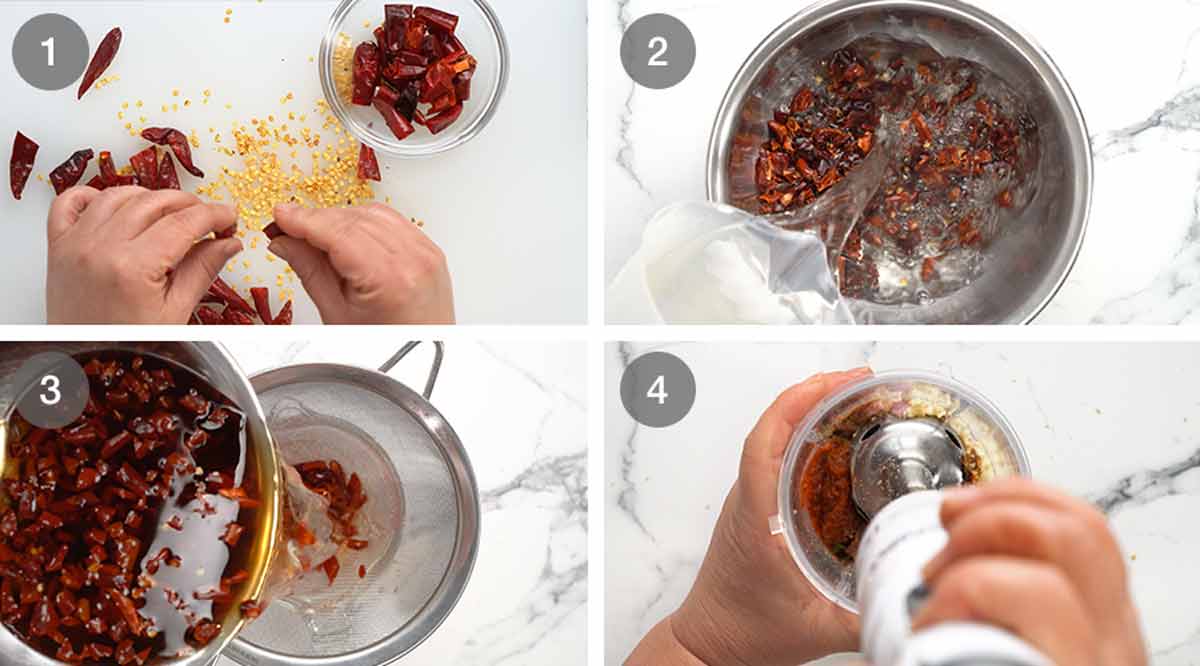
De-seed chillis – Cut the chillis in half then twist / tap / use chopsticks to remove all the seeds. Be thorough here – the seeds is where most of the spiciness is! I got slack one day and let’s just say I seriously regretted it.
Soak 30 minutes – Roughly chop the chillis then soak in boiling water for 30 minutes.
Drain and reserve the chilli soaking liquid. We will be using some for the curry paste.
Blitz – Put the peanuts into a jug just large enough to fit the head of a stick blender. Cover the jar with your hand to stop the peanuts from flying everywhere and blitz into a rough paste. Then add all the remaining curry paste ingredients and blitz until smooth. It only takes around 20 seconds or so.
Note: You can also use a small food processor. You’ll struggle to make this in a large food processor as there is not enough curry paste.
Making Panang curry
This part is nice and quick – about 10 minutes from start to finish!

Sauté curry paste – Cook the Panang Curry paste for around 5 minutes until it darkens in colour and is not wet and sloppy. This intensifies the flavour.
Sauce – Add the prawn stock, being careful to pour off just the clearer liquid and leaving the sediment behind. If using chicken as your protein, just add plain chicken stock/broth.
Add coconut cream, sugar, fish sauce and salt.
Add the beans then simmer for 2 minutes until the beans are half cooked.
Add prawns, stir, then simmer for another 2 minutes until the prawns are cooked. They cook quickly – and will keep cooking as we finish it!
Serve – Then finally, stir in the Thai basil leaves. Serve over jasmine rice garnished with chopped peanuts, chilli and more Thai basil leaves!
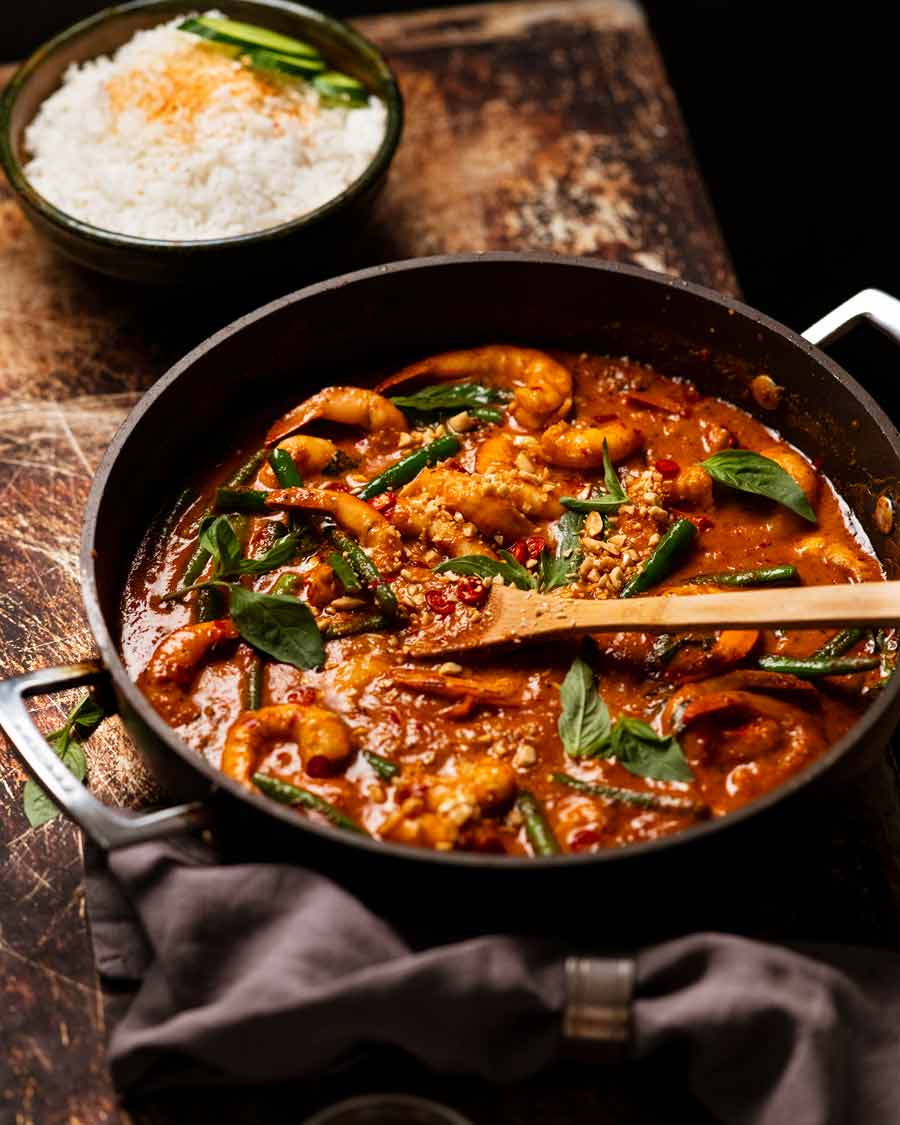
Another RecipeTin team effort!
This recipe is a RecipeTin team effort, one that I’m proud to say we created from scratch ourselves, using Panang Curry eaten in Thailand and at really reputable, authentic Thai restaurants here in Sydney as our benchmark.
We referenced many recipes during the course of our research, notably from highly regarded Thai food experts including David Thompson and Sujet Saenkham of the acclaimed Spice I Am restaurants, and YouTube videos from Thai home cooks. But we did a lot of experimentation and variations of this recipe ourselves to arrive at our final recipe, and make this a recipe accessible to people living outside Thailand.
In fact, this Panang Curry was subject to greater levels of testing than usual, including independent recipe testers, because this recipe was earmarked for my cookbook. A curry chapter that was removed at the last minute because my book was too big!😭
Anyway, I just wanted to put this big blue box here to acknowledge my teams’ efforts with this recipe, because curries are hard! Getting the spice balance just right is difficult, and you never know what the final flavour will be until right at the end. And because of the spiciness of this curry, testing it was extra painful – we tried so many different chillies!
Special shout out to my brother who was the driving force behind the development of this recipe, and Chef JB who’s probably made this curry more times than anyone else. We did it!

So, with the big blue box of thanks done, I hope those of you on the fence about trying this can have the confidence to make it knowing it’s been subject to extra thorough testing! We really do think this is an exceptional Panang Curry. You’d be hard pressed to find one as good other than at the really top tier Thai restaurants. In Sydney, I’d only recommend Long Chim and Spice I Am.
Remember – be brave with the chillies! Go on, you can do it! 😉 – Nagi x
Watch how to make it
Hungry for more? Subscribe to my newsletter and follow along on Facebook, Pinterest and Instagram for all of the latest updates.

Panang Curry – real, from scratch
Ingredients
Protein – choose ONE:
- 700g/ 1.4 lb whole raw prawns/shrimp (ie shell on), medium ~8cm / 3″long – Note 1
- 350g / 12 oz boneless, skinless chicken thighs , cut into 7mm/ 1/3" slices
For prawn stock (shrimp):
- 1 1/2 cups chicken stock/broth , low-sodium (not fish/seafood – Note 2)
Curry paste:
- 2/3 cup dried Chinese chillies (not Thai!) (24 x 6cm/2.5" long, 1/2 cup (15g) once deseeded chopped) – Note 3
- 3 tbsp roasted peanuts unsalted
- 2 lemongrass stems , finely grated (2 x 20cm/8" lengths) – Note 4
- 2 eschalots , roughly chopped (1/2 cup)
- 1 tbsp galangal, finely grated (~1.5cm / 0.6" piece) – Note 5
- 5 garlic cloves , finely minced
- 1 1/2 tbsp shrimp paste in bean oil – Note 6
- 1/2 tsp each ground coriander, cumin, nutmeg
- 1 tbsp (packed) finely sliced kaffir lime leaves (~ 6 leaves) – Note 7
Curry:
- 3 tbsp canola oil
- 1 1/4 cups coconut cream , full-fat (standard Aus 270ml small can ok)
- 3 1/2 tsp white sugar
- 4 1/2 tsp fish sauce
- 1/4 tsp cooking/kosher salt
- 200g/7oz green beans , trimmed, cut in half (~1 1/2 cups)
- 12 Thai basil leaves – Note 8
SERVING and GARNISHES
- Jasmin rice
- 2 tbsp unsalted peanuts , finely chopped
- Red cayenne peppers , finely sliced (optional)
- Thai basil leaves , 3 leaves per serving – Note 8
Instructions
Prawn stock:
- Simmer – Peel and devein prawns, reserving heads and shells. Bring chicken stock to a simmer in a small pot on high heat. Add prawn heads & shells, bring back to a simmer, then reduce to low heat. Simmer uncovered for 15 minutes, periodically crushing the heads lightly with a potato masher and skimming off any orange scum.
- Strain into a jug, discarding heads. You should have just over 300 ml (1 1/4 cups) of stock. Leave undisturbed to let the sediment settle (~ 5min+).
Curry paste:
- Cut chillies in half then tap / squeeze out seeds (use a chopstick if needed for stubborn seeds). Discard seeds (spicy!). Chop chilli.
- Soak dried chillis in 2 cups of boiling water for 30 minutes. Drain in a colander, reserve soaking liquid.
- Peanuts – Put peanuts in a tall jar that comfortably fits the head of a stick blender (or use a small blender). Cover the jar opening with your hand and pulse until finely ground.
- Blitz paste – Add drained chillis and remaining Curry Paste ingredients, along with 1/4 cup of the reserved chilli soaking liquid. Blend, scraping down the sides as you go, for about 30 seconds until smooth, using extra chilli water only if needed to help blend.
Cooking:
- Cook curry paste – Heat oil in a large deep frying pan over medium-low heat. Cook curry paste for 5 minutes, stirring constantly. The paste should be drier, darker, smelling aromatic and no longer raw.
- Sauce – Add 1 cup (250 ml) prawn stock, being careful to pour off just the clearer liquid and leaving the sediment behind. Stir in the coconut cream, sugar, fish sauce and salt. Mix in the green beans.
- Simmer for 2 minutes until the sauce thickens and the beans are half cooked.
- Add prawns, stir, then simmer for another 2 minutes until the prawns are cooked. Stir in the Thai basil leaves. The final taste should lean mostly savoury and sweet, and medium spiciness.
- Serve over jasmine rice garnished with chopped peanuts, chilli and more Thai basil leaves!
Recipe Notes:
1. Proteins – I think juicy prawns go particularly well with panang curry, plus you get to re-purpose the heads to get free, bonus flavour into the stock which makes this really special. If using pre-peeled prawns, using 350g/12 oz and skip the stock making steps. Chicken – Recipe works perfectly with chicken too! Use 350g/12oz, thinly sliced. Skip the stock making steps, cook chicken as per recipe does with prawns. 2. Chicken stock? Yes! Store bought fish/seafood stock is really not good. But chicken stock is much better, and gets infused with prawn flavour from the prawn heads (which is where most of the prawn flavour is!). 3. Use Chinese dried chillies, not Thai or Indian! I know it sounds strange to tell you to avoid Thai dried chillies but they are SUPER spicy and don’t reduce in spiciness much when cooked. Same with some Indian ones are too (like kashmiri). My team and I did a lot of testing around chilli types for this curry re: excessive spiciness. Check label for country of origin, use Chinese chillies. Though the spiciness of Chinese chilli types and brands will vary, I found that the cooking process in this curry reduces the spiciness of the chillies so they end up being the same level of spiciness. Be brave! Try not to reduce the chilli too much because they are also a key flavouring for the sauce. If you can’t handle spicy food, I suggest skipping this recipe! Quantity – Dried chillies vary in length so the number you need will vary, from (say) 12 very large ones to 40 small ones for 2/3 cup when whole (20g, with seeds in). You need enough so you have 1/2 cup (15 g) chillies once chopped / deseeded. Be sure to deseed thoroughly – the seeds are where most of the spiciness is! 4. Lemongrass prep – cut the reedy end off, we’re only using the white and pale green part, around the bottom 20cm/8″. Trim root off, peel off reedy outer layer. Then grate using a microplane, discard stringy bits left. Sub: Fresh is best here but if you can’t get it, use 1 tablespoon of lemongrass paste instead. 5. Galangal – looks like ginger but is more citrusy and harder. It’s pretty tough so best to grate to ensure your curry paste is smooth. You can find it in Asian stores + some grocery stores in Australia (Harris Farms and some Woolworths sell it). Sub: use the same amount of ginger + 1/4 tsp lime zest. 6. Shrimp paste in bean oil – I use Por Kwan Shrimp Paste in Bean Oil, the most popular one sold at Asian grocery stores here in Australia. Substitute with 1 1/2 tsp belacan dried shrimp paste, roughly chopped (even sold at Woolies in Australia!) + 1 tsp oil + 1 tsp fish sauce + 1 garlic clove + 1 tsp miso, if you can – any type). Use in place of shrimp paste in recipe. 7. Kaffir lime leaves – Earthy lime flavour unlike anything else! Sold at Asian stores, Harris Farms & large grocery stores in Australia. Freezes 100% perfectly – used in Thai red curry, coconut rice, Thai meatballs. 8. Thai basil leaves – Fresh herb used in Thai cooking that tastes like Italian basil with a slight aniseed flavour. Sub with Italian basil. 9. Leftovers will keep for 3 days in the fridge or 3 months in the freezer. Keep basil separate – it degrades once stirred in. Nutrition per serving assuming 5 servings, excluding rice.
I adore Thai curries
See?
Life of Dozer
Getting fitted for a special reader dinner coming up next week at the Four Seasons hotel in Sydney! YES, Dozer will be waddling around a ballroom in his tux. 😂 There’s still some tickets available – see below for information!

Tickets here for a dinner hosted by Dymocks book store at the Four Seasons Hotel in Sydney on Thursday 10th August. Ticket price includes a 3 course meal developed with the Chef at the hotel in collaboration with our very own Chef JB, as well as all beverages!






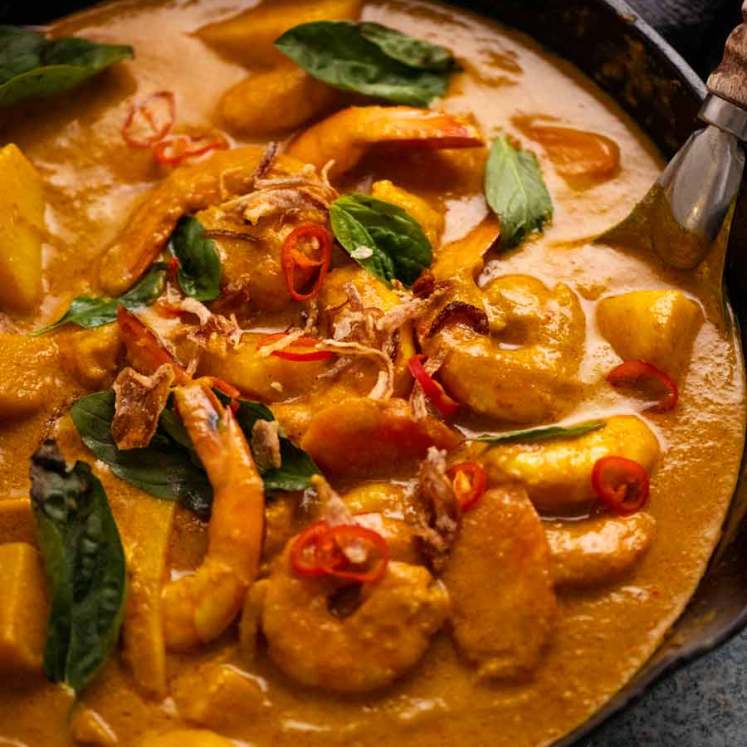

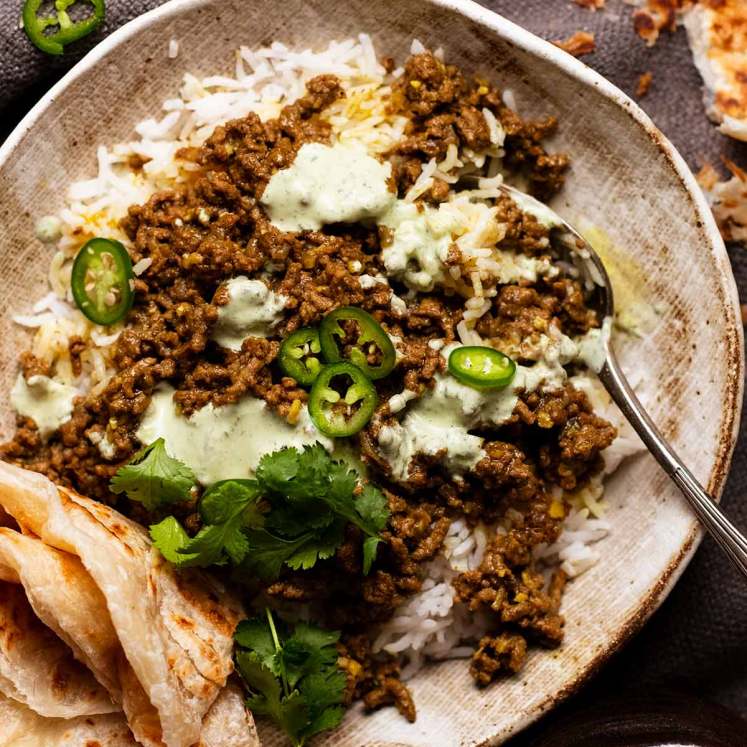

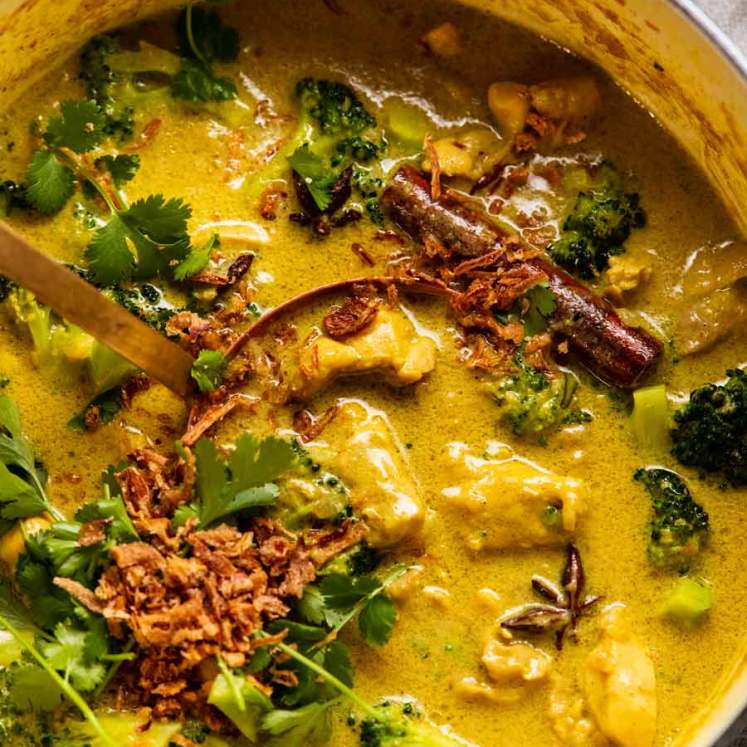
I was brave enough to make this curry. Let me tell you the flavour is out of the world, definitely making it again now that i have the ingredients.
I have spent a week organizing my Asian kitchen to gather everything needed for this recipe, Panang shrimp curry. My local Asian grocery didn’t have the shrimp paste at 10:00 AM yesterday and told me to come back at 3:00 PM, go figure, at 3:00 PM I was holding a jar of Por Kwan Shrimp Paste with Bean Oil. I live in central Minnesota, USA. Where did they find it? On Thursday this week, I’m making the recipe. I have everything together now. This recipe will be a major undertaking. I can’t wait to make and enjoy it.
I AM SO IMPRESSED WITH YOUR PERSISTENCE STUART!!! I hope you love it. It’s really special! I have the toughest critics in my team who are VERY fussy about getting recipes just right (my brother and my chef JB) and we all stand by this recipe. Better than anything from a jar, and very hard to find one this good at a restaurant outside Thailand!! N x
OMG! It’s 2:00 PM and I have been prepping and cleaning up all day. I thought I had most of the prep and organizing done….WRONG. I got the shells together and the low sodium chicken broth and boiled for 15 min then strained and brought the broth up to 12 ounces. I de’veined’ the shrimp. They are slippery little devils. I forgot to prep the green beans which will be nothing to do. I don’t think I will ever undertake this recipe again. I enjoy a glass of wine when I’m prepping and cooking, but, with this intricate recipe I’m afraid I’ll screw it up if I have a glass of wine. You should see my mise en place. Covers half my kitchen table. I need a nap. I need to set up my Thai Homali rice. I made 50 egg rolls and I’ll air fry two as appetizers for tonight. I plan on making Char Siu this weekend. I love to cook and I love the process of making things. Thanks for giving me the opportunity to indulge my passion for cooking. stu b
Cooked this tonight and the flavours were to die for. Followed the recipe exactly. Prep is quite a bit even with both of us doing it, but well worth it. Hubby and I both thought it would’ve had a bit more kick. Will definitely cook again.
It was fabulous. It also was a huge amount of work, prepping and cooking everything in the correct order. I won’t be making it again. Way too much work for one person to do, prepping, cooking and clean-up.
YES!!! I’m so glad you enjoyed it Katrina!! N xx
Planning on making this curry today. I have shrimp paste but not in bean oil – does it have to be?
Hi Mel! Sorry for the late response. Shrimp paste not in bean oil is a fine substitute. The bean oil one has a little more flavour in it – more ingredients – but the paste is a very good substitute! I will actually add that into the notes because it’s better than the dry shrimp I suggested. – N x
Perfect? Now I did make this and the flavour was amazing just one issue – no hot spice – like at all!! Not sure how this could be given I used the 2/3 cup of dried chillies bought from the Asian Store. I’m so confused as to why? Guess I may have to try it again.
Hi Nagi! The (only!) Asian grocer in town only had Thai and Indian chillis. Could you please recommend a brand/website that I could order Chinese ones from? Thank you xx
Ohhhh yes! Thank you 🙌🏼 I’ve been waiting for this one. On a side note I found a maesri Panang curry paste at my local Asian grocer a few weeks ago and bought it based on the fact that I use the red curry paste with extras (your recipe), but looks like that will be getting discarded 😂
Don’t get me wrong Danny! It’s still a tasty curry, it’s just not quite a real Panang 🙂 You can literally use my Thai Red curry recipe but use the Maesri Panang curry paste instead N x
I went to Woolies and 3 Asian grocers and none of them had the Chinese chillies. Can I use fresh instead?
Hi Naomi! Sadly fresh does not have the same flavour, its missing the earthiness 🙁 Thank you for the question though, I will pop that tip in! I’m so surprised none of the Asian grocers had Chinese dried chillies. Let me have a look online, I’ll come back! – N x
Okay I ignored Nagi and used Thai chillies and it was a (delicious) inferno
Inferno!!! OMG yes using Thai chillis “inferno” is the PERFECT word! I’m impressed you handled the heat Jake… I really suffered. REALLY 😂
Wow made this today and we have just eaten it. Amazing beautiful flavours and hot! I think I may have used Thai chillis instead of Chinese. Regardless it was fantastic and will become a favourite. Thanks so much for sharing
YOU MADE IT!!! I think you’re the first Sheila 🙂 So glad you enjoyed it – and handled the heat! N xx
Oh, my stars!! This recipe is fantastic! The hubs doesn’t like spicy and he had seconds. I didn’t have shrimp paste so left that out, but otherwise followed as written. It’s as good as my favorite local Thai restaurant. Will make again soon.
This looks WOW!! I will definitely be giving this a go, but I’ll have to get to an Asian grocer somehow, there isn’t one where I live (country Victoria), and a dish like this definitely deserves using the proper ingredients. And no, I’m not afraid of the spiciness! Bring it on, I say. We quite happily eat Vindaloo. Thanks for your recipes, Nagi. I did the chorizo and chickpea stew the other night, I added more veges and increased the thyme and smoked paprika. Delicious!
Can’t wait to try this. I have all the ingredients but what is the difference between Thai chilli and Chinese chilli?
heat level. She does say it in the blog post and notes!
Stupid me!! Thank you for replying, really appreciate it. I don’t know how I missed it.
Hi Nagi and fellow Nagi fans!
I have bought 4 copies of the book for myself and various friends, can’t believe the curry chapter was dropped! Would have made a fantastic collection even better!
As for this recipe, I can’t wait!
A mate just dropped off a kilo of dried Chinese dried chillies that he p[icked up for me, so looks like the stars are aligning!
I wonder if anyone has tried this with Maesri Panang curry tins? I mistakenly bought two thinking they were the red curry variant and now have no idea what to do with them
Nagi I have been waiting for a Penang Curry recipe from you for ages!! I can’t believe you dropped this from the cookbook! It’s going straight to the top of my ‘to-make’ list.
I have no way of knowing for sure, but, I would think the curry section and recipe was dropped from the book was because of the difficulty in finding ingredients and very very labor intensive. Did I say, ‘labor” twice I should have said it 3 times.
Hi Stuart!! It was dropped because I had to cut a chapter out due to book size, and most of the curries could fit in neatly into another home – like the Everyday Chapter for Butter Chicken – but the Panang didn’t have another home because as you say it is a little more difficult to explain all the ingredients 🙂 I was pretty gutted, we worked so hard on the recipe! N x
You dropped the ‘Curry Chapter’ from your book – ahhhhhhh, the humanity!
Hi Nagi! I’m so excited to see this! Just a question if you experimented with maesri’s panang paste like you did for your green curry recipe ? And if so, were you not a fan ? Or could we use that can + some of the paste ingredients in your above recipe to make this?
This is mentioned in the blog post. It’s not quite the standard compared to making your own paste 🙂
Ah, silly me! I was too excited, I hit “jump to recipe” and missed it, Thanks!
This looks amazing. Love the flavours of lemongrass, kaffir, galangal etc.
With the shrimp paste in bean any idea how long it will last in the fridge? Never seen it in any other recipes so not sure how to use it up.
Love love love your work!! Xx
Where can I get Chinese chillies,what brand if I’m looking on Amazon, cant find any so far!
Love the panang recipe I love spice ..wish I could be there August 10 to say hello bigh hug to both of you
What a shame the recipe is so spicy. Hubby and I buy the Penang Curry from Thai restaurants all the time in Sydney and up here in Coffs. Its nowhere near as hot as you describe. It’s never hotter than a red curry because hubby cant do hot.
I was so excited when I first saw the recipe.
I lived in Thailand and Panang curry was one of my staples. It was as hot as Nagi describes. Perhaps the Panang you are having is customized to suit a more subtle palate in terms of spice level. Anyway! I’m sure Nagi and her team worked forever to create the perfect recipe and I’m so excited to try this. My Thai curry dreams came true when I woke up this morning and saw this. Thanks, Nagi!!